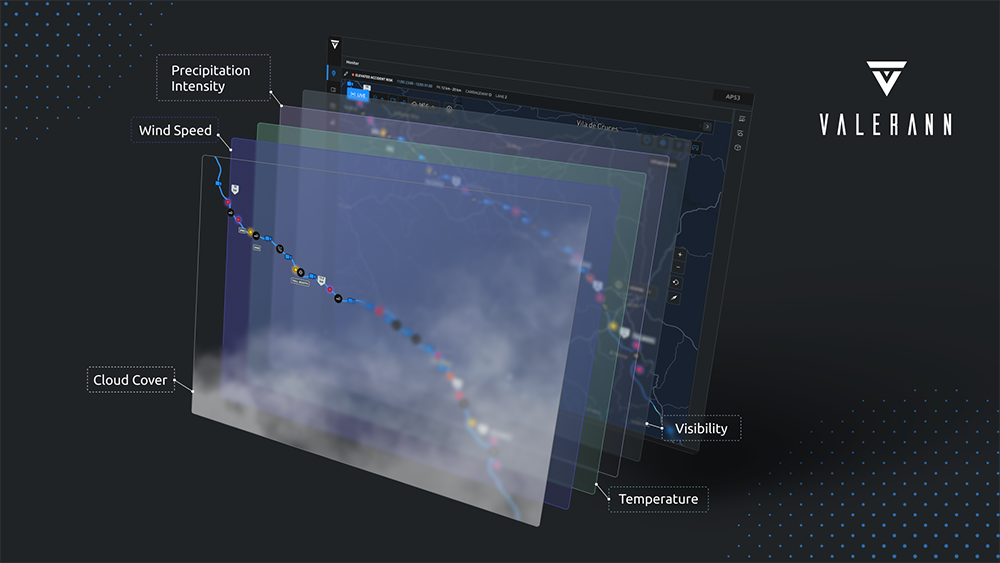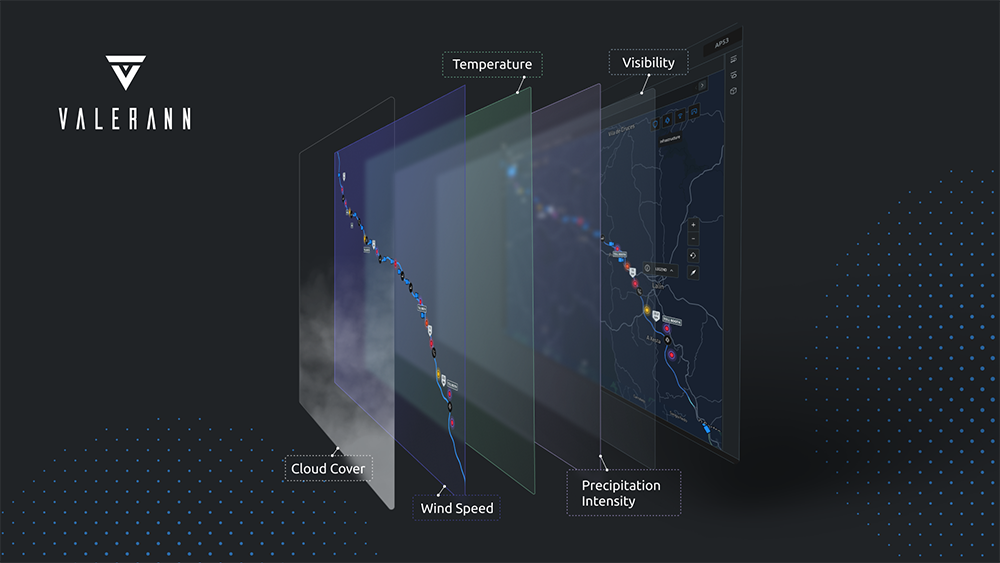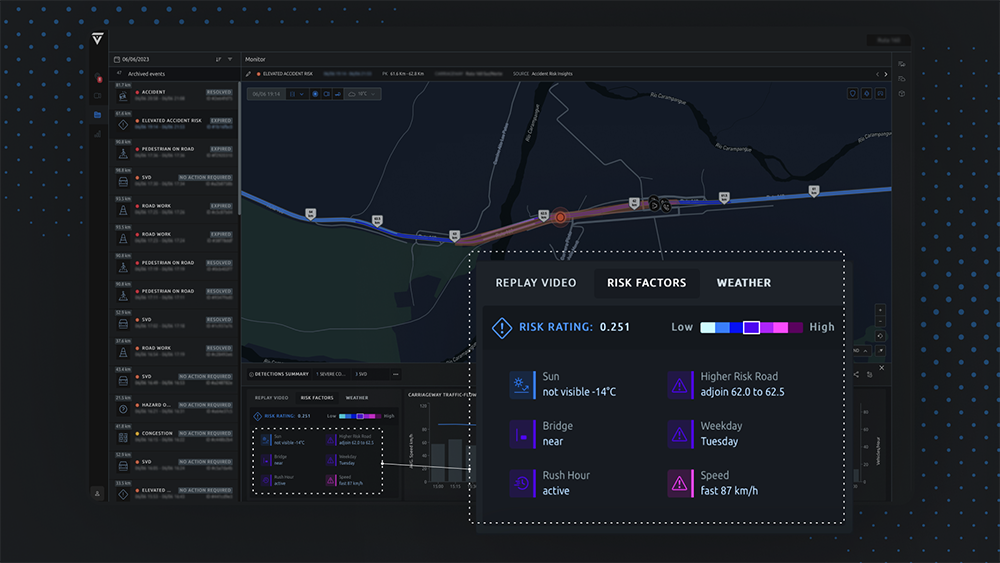
One of the most-desired capabilities of a 21st century traffic management solution is the ability to provide a risk profile for the road or network. In real-time, a risk profiler outputs relative and absolute risk conditions, alerting road operators of areas where there is an elevated risk of an accident. Reducing the risk of drivers and passengers being killed or seriously injured on the roads perfectly fits into the challenges of striving towards the stated goals of Vision Zero.
To produce accurate road incident risk prediction in real time, complex mathematical risk models consider a broad range of parameters: historical road incident data, weather conditions and traffic volumes, as well as risk multipliers such as harsh braking, acceleration, visibility, wind speed, hazards and road topography. By leveraging these insights, operators can build upon their expert knowledge, identifying granular factors contributing to potential incidents. This allows them to develop operational plans for improved traffic management and safety.
"To produce accurate road incident risk prediction in real time, complex mathematical risk models consider a broad range of parameters"
Lanternn by Valerann’s risk profiler is a machine learning model that leverages a combination of real-time and historical data inputs and relies on three levels of analysis: Historical Accident Data, Risk Multipliers and Expert Knowledge.
These three analysis engines power the risk profiler, with each engine ingesting and processing real-time data related to the road or network, such as weather conditions, traffic status and live events to ascertain the overall level of risk at each location. As more expert knowledge or actual accident data is accrued, each of the machine learning models are updated accordingly.
To put it simply, Lanternn by Valerann takes 10 years of accident data, puts it into the engine, for it to find patterns and correlation. Add on top current weather conditions, traffic situation in the area and other parameters affecting traffic flow, such as large concerts or sporting events, or even upcoming country-wide holidays. And after processing all these data points the engine analyses the entire situation then predicts risk. All in real time. This is a very powerful tool in terms of harnessing Big Data.

Using real-time data, the risk profiler continuously calculates the relative and absolute risk levels of the road, with the results graphically visualised within a GIS map. Absolute risk conditions that exceed a threshold also trigger active alerts to notify operators of high-risk situations.
"We take 10 years of accident data, put it into the engine, it then finds patterns and correlation, and then predicts risk. This is a very powerful tool in terms of harnessing Big Data"
This enables resources to be prioritised and actioned in real-time based on the risk profile of the road or network, ensuring preventative and proactive response. For example, a patrol vehicle can be positioned based on locations with the highest relative risk to ensure rapid response should an accident occur. Warnings of high-risk conditions can additionally be communicated to drivers through VMS, V2X or social media.
Situational Awareness
A new emerging class of AI-based solutions significantly enhance situational awareness for road traffic authorities, ultimately empowering them to increase road safety. Until recently, AI and machine learning have not been widely deployed for road traffic use cases. The rapid growth in road traffic data and computational resource availability now presents opportunities for in-depth analysis that can be used for tactical and strategic improvements to reduce risk. AI solutions can deliver a holistic road traffic overview for better road management, eliminating blind spots and extending road monitoring coverage to 100%. However, notifying road operators about potential risks in a timely manner is nothing short of a game-changing development for the industry.

We can also detect wrong-way driving which is exceptionally risky behaviour that we see with shocking frequency in some of the areas where we operate and we've developed algorithms that identify when animals are on the road. In some of the geographies we're operating in, that can be extremely dangerous. If you've got a lot of sheep wandering onto the motorway, we can flag that in near real time to the operators for them to do something about it and, again, save lives.
We have a very comprehensive range of risk assessment inputs, but we're looking at a huge range of different sources to ascertain what we deem to be a risk, ranging from road conditions and current weather, to the location of infrastructure, such as tunnels and bridges, to traffic patterns which we collect and analyse over an extended period of time. This holistic approach gives us a much richer picture of potential hazards and the quantification of road risk. As soon as we think that there's some ice or snow on the way, we'll dynamically adapt our risk model to meet those changing conditions. Stakeholders need to be able to make very up-to-date decisions based on that real time information.”
"We have a comprehensive range of risk assessment inputs, but we're looking at a huge range of different sources to ascertain what we deem to be a risk, from road conditions and current weather, to the location of tunnels and bridges, to traffic patterns"
A degree of visibility
Our company is in the throes of developing a range of AI models to calculate risk. It’s not unfair to say that AI technology and machine learning can result in “black box algorithms” that are impossible for business analysts or customers to understand.
In safety-critical settings, it's really important that we understand why particular decisions were made. If it turns out that an incorrect decision is made on the basis of a piece of software, we need to understand what process has led to that decision being made. So one of the things that we've worked really hard to try to achieve is making those rules transparent, such that they can be modified and understood by people who might not necessarily have a detailed coding development background. We think of it as rather than a black box we have created a glass box.”

The notion of “explainability” is a lot more important to road operators than the word might at first suggest. It’s all well and good knowing that a risk exists but a road operator needs to know how to deal with it, how to manage it and what can be achieved in a very short space of time. This is especially true in relation to Vision Zero and the global goal to reduce the number of fatalities or seriously injured people in road accidents to nil. After its initial implementation in Sweden in the 1990s the Vision Zero strategy has been successfully rolled out across Europe and has made major inroads across the globe, notably in North America. Enabling road operators to see potential risks of accidents on their road network has to be seen as a significant plus.
Because we are using this fusion step that combines different ways of putting in risk, we can basically show our work. There’s no opaqueness or obfuscation. The road operators can see the reasons why that particular road is particularly risky at the particular time. If they know what is wrong at any given moment they can react appropriately.”
It’s at this point in the process that lives can be saved.
"Because we are using this fusion step that combines different ways of putting in risk, we can basically show our work. There’s no opaqueness or obfuscation"
Improved situational awareness
Lanternn by Valerann has an exceptional feature – a weather layer that visualises the current weather conditions, be it clouds, rain or clear sky, helping to complete the road traffic situation picture. It is a welcome addition to the system’s computer vision algorithms that are able to identify reduced visibility, such as fog, enabling road managers to take preventative measures, like changing their Variable Message Signs to warn drivers of the dangerous conditions and the subsequent change in speed limits. Crucially, this significantly reduces the likelihood of those accidents.
The weather layer is complementary to the already powerful platform that knows pretty much everything about the road – even when a central barrier is broken.
Operations staff can toggle between the traffic layer and the risk, adding the weather layer on top, and see the correlation between the three. The highly undesirable scenario of an impending thunderstorm that will lead to dangerously wet roads, followed by bright sunlight can be counteracted thanks to the increased risk being highlighted by the vast amount of relevant historical data and weather forecast.

This is already happening on some of our deployments. The combination of the weather layer with the risk model that enables intelligent decisions to be made about reducing speed and preventing collisions is ultimately saving lives.
Achieving Vision Zero on our roads is not just a reality - it’s a right. After all, why should drivers put their lives at risk simply by going about their daily business?
Watch the video here
Content produced in association with Valerann












